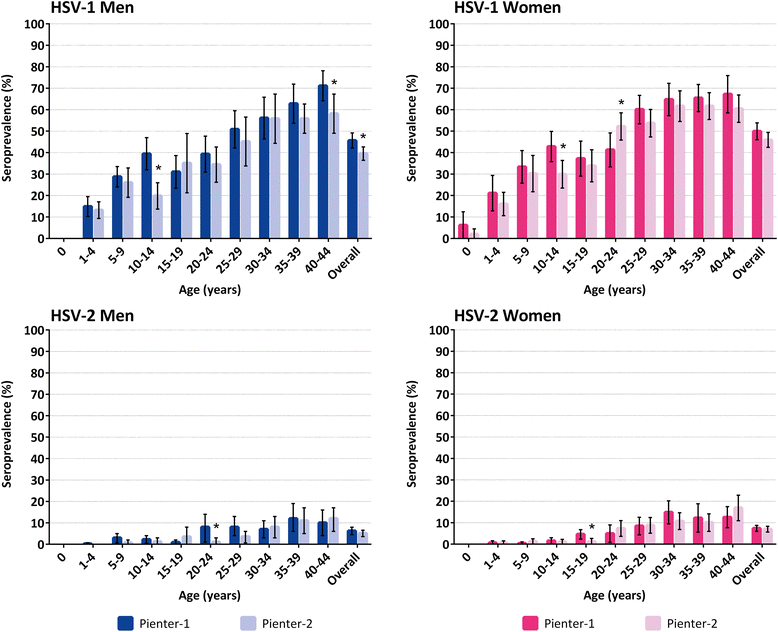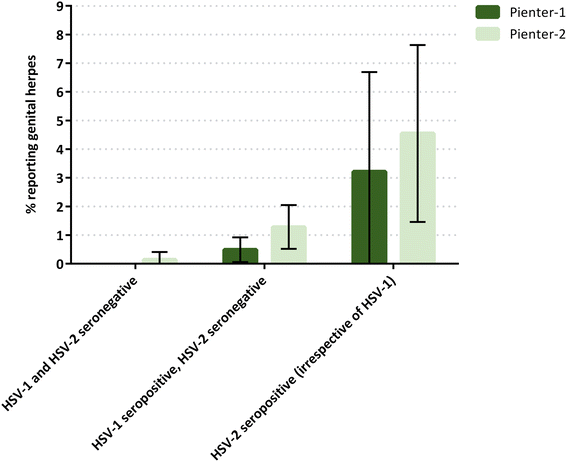Herpes simplex virus type 1 and type 2 in the Netherlands: seroprevalence, risk factors and changes during a 12-year period
- PMID: 27484304
- PMCID: PMC4971663
- DOI: 10.1186/s12879-016-1707-8
Herpes simplex virus type 1 and type 2 in the Netherlands: seroprevalence, risk factors and changes during a 12-year period
Abstract
Background: Genital herpes results in considerable morbidity, including risk of neonatal herpes, and is increasingly being caused by Herpes Simplex Virus (HSV) type 1. Possibly children are less often HSV-1 infected, leaving them susceptible until sexual debut. We assessed changes in the Dutch HSV-1 and HSV-2 seroprevalence over time and determinants associated with HSV seropositivity.
Methods: We used data from two population-based seroepidemiological studies conducted in 1995-6 and 2006-7 with a similar study design. Serum samples of 6 months to 44-year-old participants were tested for type-specific HSV antibodies using HerpesSelect® with a cut-off level of >1.10 for seropositivity. Age and sex-specific HSV-1 and HSV-2 seroprevalence was weighted for the Dutch population. Logistic regression was performed to investigate determinants associated with HSV seropositivity.
Results: Overall, weighted HSV-1 seroprevalence was significantly lower in 2006-7 [42.7 % 95 % confidence interval (CI) 39.9-45.4] than in 1995-6 (47.7 % 95 % CI 44.8-50.7), especially among 10- to 14-year-olds. Overall, weighted HSV-2 seroprevalence remained stable: 6.8 % in 1995-6 and 6.0 % in 2006-7. Adults who ever had sexual intercourse were more often seropositive for HSV-1 [adjusted Odds Ratio (aOR) 1.69 95 % CI 1.33-2.16] and HSV-2 (aOR 2.35 95 % CI 1.23-4.52). Age at sexual debut was the only sexual risk determinant associated with HSV-1 seropositivity.
Conclusions: Because of the lower HSV-1 seroprevalence in 2006-7 compared to 1995-6, more adults are susceptible to genital HSV-1, including women of reproductive age. Given the higher risk of neonatal herpes when HSV is acquired during pregnancy, prevention and control measures during pregnancy also targeting HSV-1, are important.
Keywords: Genital herpes; HSV-1; HSV-2; Herpes simplex virus; Public health; Seroprevalence.
Figures


Similar articles
-
Decreasing seroprevalence of herpes simplex virus type 1 and type 2 in Germany leaves many people susceptible to genital infection: time to raise awareness and enhance control.BMC Infect Dis. 2017 Jul 6;17(1):471. doi: 10.1186/s12879-017-2527-1. BMC Infect Dis. 2017. PMID: 28683784 Free PMC article.
-
Seroprevalence and correlates of herpes simplex virus type 2 infection among young adults in Arkhangelsk, Northwest Russia: a population-based cross-sectional study.BMC Infect Dis. 2016 Oct 28;16(1):616. doi: 10.1186/s12879-016-1954-8. BMC Infect Dis. 2016. PMID: 27793121 Free PMC article.
-
Seroprevalence of herpes simplex virus type 1 and type 2 in selected German populations-relevance for the incidence of genital herpes.J Med Virol. 2000 Jun;61(2):201-7. doi: 10.1002/(sici)1096-9071(200006)61:2<201::aid-jmv5>3.0.co;2-p. J Med Virol. 2000. PMID: 10797375
-
Epidemiology of herpes simplex virus type 2 in Latin America and the Caribbean: systematic review, meta-analyses and metaregressions.Sex Transm Infect. 2021 Nov;97(7):490-500. doi: 10.1136/sextrans-2021-054972. Epub 2021 Jun 4. Sex Transm Infect. 2021. PMID: 34088792 Free PMC article.
-
Epidemiology of genital herpes simplex virus infection in developed countries.Herpes. 2004 Apr;11 Suppl 1:2A-23A. Herpes. 2004. PMID: 15115626 Review.
Cited by
-
Seroprevalence of Infections with TORCH Agents in Romania: A Systematic Review.Microorganisms. 2023 Aug 20;11(8):2120. doi: 10.3390/microorganisms11082120. Microorganisms. 2023. PMID: 37630680 Free PMC article. Review.
-
The Effect of HSV-1 Seropositivity on the Course of Pregnancy, Childbirth and the Condition of Newborns.Microorganisms. 2022 Jan 14;10(1):176. doi: 10.3390/microorganisms10010176. Microorganisms. 2022. PMID: 35056624 Free PMC article.
-
Herpes virus seroepidemiology in the adult Swedish population.Immun Ageing. 2017 May 10;14:10. doi: 10.1186/s12979-017-0093-4. eCollection 2017. Immun Ageing. 2017. PMID: 28491117 Free PMC article.
-
Seroprevalence and associated factors of HSV-2 infection among general population in Shandong Province, China.BMC Infect Dis. 2019 May 6;19(1):382. doi: 10.1186/s12879-019-3995-2. BMC Infect Dis. 2019. PMID: 31060582 Free PMC article.
-
Decreasing seroprevalence of herpes simplex virus type 1 and type 2 in Germany leaves many people susceptible to genital infection: time to raise awareness and enhance control.BMC Infect Dis. 2017 Jul 6;17(1):471. doi: 10.1186/s12879-017-2527-1. BMC Infect Dis. 2017. PMID: 28683784 Free PMC article.
References
-
- Corey L, Wald A. Genital herpes. In: Holmes KK, Sparling PJ, Stamm WE, Piot P, Wasserheit JN, Corey L, Cohen MS, Watts DH, editors. Sexually transmitted diseases. 4. New York: McGraw-Hill; 2008. pp. 399–437.
MeSH terms
Supplementary concepts
Associated data
LinkOut - more resources
Full Text Sources
Other Literature Sources

